Jawaharlal Nehru Technological University Kakinada 2009 B.Tech Electrical and Electronics Engineering I Supplementary s, - Question Paper
here i upload the paper to download this...
please click on beneath link...........
Code No: Z0105/R05 Set No. 1
I B.Tech Supplementary Examinations, November 2009 ENGINEERING GRAPHICS ( Common to Civil Engineering, Mechanical Engineering, Mechatronics, Metallurgy & Material Technology, Production Engineering, Aeronautical Engineering and Automobile Engineering)
Time: 3 hours Max Marks: 80
Answer any FIVE Questions All Questions carry equal marks
1. (a) A room of 1728 Cu.m volume is shown by a cube of 216 Cu.cm volume. Find
R.F and construct a plain scale to measure up to 42 m. Mark a distance of 27m on the scale. [16M]
(b) Draw a plain scale to show kilometers and hectometers, when R.F is 1: 35,000and long enough to measure 5 Km. Measure 3.9 Km on the scale. [8+8]
2. A circle of 60 mm diameter rolls on a horizontal line for half a revolution clock -wise and then on a line inclined at 60 degrees to the horizontal for another half, clock - wise. Draw the curve traced by a point P on the circumference the circle, taking the top most point on the rolling circle as generating point in the initial position. [16M]
3. A line AB 75mm long has its end A in the H.P. and 12 mm in front of V.P. the line is inclined at 60 degrees to H.P. and 30 degrees to V.P. Draw projections. [16M]
4. A cylinder, 65 mm diameter and 90 mm long, has its axis parallel to the H.P. and inclined at 30 degrees to the V.P. It is cut by a vertical section plane in such a way that the true shape of the section is an ellipse having the major axis 75 mm long. Draw its sectional front view and true shape of the section. [16M]
5. A cylinder of diameter 100 mm(vertical) is penetrated by another cylinder of diameter 40 mm(horizontal). The axes of both the cylinders intersect at right angles. Draw the curves of intersection. [16]
6. Draw the isometric view of a cone 40 mm diameter and axis 55 mm long when its axis is horizontal. Draw isometric scale. [16]
7. Convert the isometric view of the picture shown in the figure 7 in to orthogonal projection of all three views. [16]
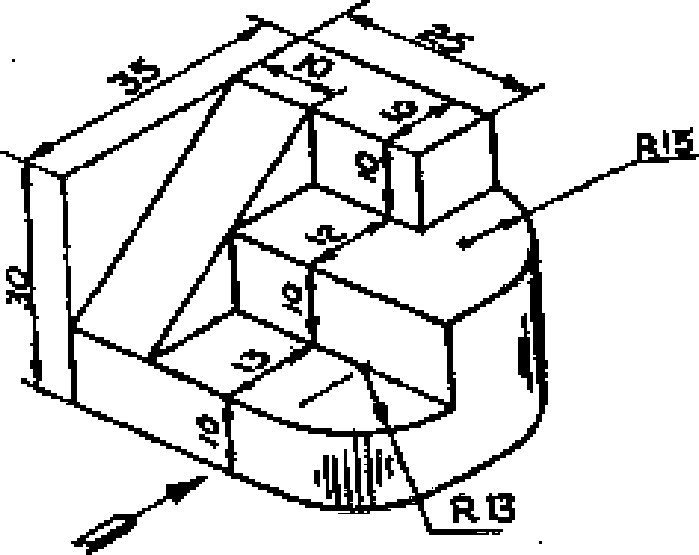 |
|
Figure 7 |
8. A square is resting on ground plane on one of its corners and is some distance behind VP. Its plane is perpendicular to HP and inclined at 30o to the VP and the sides containing the corner are equally inclined to the HP. Determine the line of heights for points lying in its top view and then draw its perspective view from the given position of the station point. [16]
I B.Tech Supplementary Examinations, November 2009 ENGINEERING GRAPHICS ( Common to Civil Engineering, Mechanical Engineering, Mechatronics, Metallurgy & Material Technology, Production Engineering, Aeronautical Engineering and Automobile Engineering)
Time: 3 hours Max Marks: 80
Answer any FIVE Questions All Questions carry equal marks
1. On a map, the distance between two points is 14 cm. The real distance between them is 20 Km. Draw a Diagonal scale of this map to read kilometers and hecta meters, and to measure up to 25 Km. Show a distance of 17.6 Km on this scale.
[16M]
2. Construct a parabola in a rectangle 40mm X 60 mm. Locate the foci and draw target x normal at any point on the curve. [16M]
3. Three lines OA, OB and OC are respectively 25 mm, 45 mm 65 mm long, each making 120 degrees angles with the other two and the shortest line being vertical. The figure is the top view of the three rods OA, OB and OC whose ends A, B and C are on the ground, while O is 100 mm above it. Draw the front view and determine the length of each rod and its inclination with the ground. [16M]
4. A hexagonal prism of base of side 30mm and axis length 70mm rests on one of its corners on the HP, the two edges of the base containing the corner being equally inclined to the HP. The axis is inclined at 300 to the HP and parallel to VP. The prism is cut by a plane perpendicular to the VP and inclined at 450to the HP. The cutting plane meets the axis at a distance 34 mm from the top end. Draw its front, the sectional top views and the true shape of the section. [16M]
5. A cylinder of diameter of base 60 mm altitude 80 mm stands on its base. It is cut into two halves by a plane perpendicular to the VP and inclined at 30o to HP. Draw the development of the lower half. [16]
6. A pentagonal prism of base 40 mm and axis 70 mm long has a central triangular hole of side 30 mm cut through one of the rectangular faces. Draw the isometric view of the prism. [16]
7. Draw the elevation, plan and side view of the picture shown in the figure 7. [16]
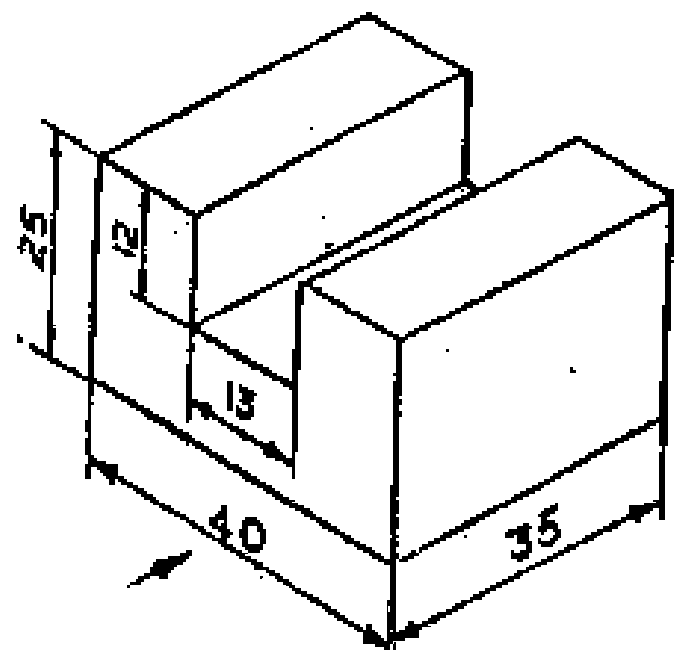 |
|
Figure 7 |
8. A rectangular block, 32 mm X 22 mm X 16 mm is lying on ground on one of its largest faces. One of its vertical edges is in the picture plane and the longer face containing that edge is inclined at angle of 30o to the picture plane. The station point is 52 mm in front of the picture plane, 35 mm above the ground plane passing through the center of the block. Draw the perspective view of block. [16]
k k k k k
I B.Tech Supplementary Examinations, November 2009 ENGINEERING GRAPHICS ( Common to Civil Engineering, Mechanical Engineering, Mechatronics, Metallurgy & Material Technology, Production Engineering, Aeronautical Engineering and Automobile Engineering)
Time: 3 hours Max Marks: 80
Answer any FIVE Questions All Questions carry equal marks
1. (a) Draw a Plain scale of 1cm= 5 metres and show on it 3.6 metres.
(b) Construct a scale of 1:4 to show centimeters and long enough to measure up to 6 decimeters and show on it a length of 4.5 decimeters. [8+8]
2. The foci of an ellipse are 100 mm apart and the minor axis is 70 mm long. Determine the length of the minor axis and draw half the ellipse by concentric circles method and the other half by Oblong method. Draw a curve parallel to the ellipse and 25 mm away from it. [16M]
3. A pentagonal plane of 30 mm side has one of its sides in the V.P. and inclined at 60 degrees to the H.P. while the surface of the plane makes an angle of 40 degrees to V.P. Draw the projections. [16M]
4. (a) A cone of base 50 mm diameter and axis 65mm long, lies on HP on of its
generators with its axis parallel to VP. A horizontal section plane bisects the axis of the cone. Draw the front and sectional top views.
(b) A square prism, side of base 30mm and axis 60mm long, rests with its base on HP and one of its rectangular faces is inclined at 300 to VP. A section plane perpendicular to VP and inclined at 600 to HP cuts the axis of the prism at a point 20mm from its top end. Draw the sectional top view and true shape of the section. [16M]
5. A cone of base diameter 80 mm and height 125 mm stands with its base on the HP. It is penetrated by a horizontal cylinder of diameter 35 mm. If the axes of the two solids intersect at a point on the cone's axis 40 mm above the base, draw the projections of the curves of intersection. [16]
6. A cylinder of base diameter 30 mm axis 60 mm is resting centrally on a slab of 60 mm square and thickness 20 mm. Draw the isometric projection of the combination of the solids. [16]
7. Draw the elevation, plan and side view of the picture shown in the figure 7. [16]
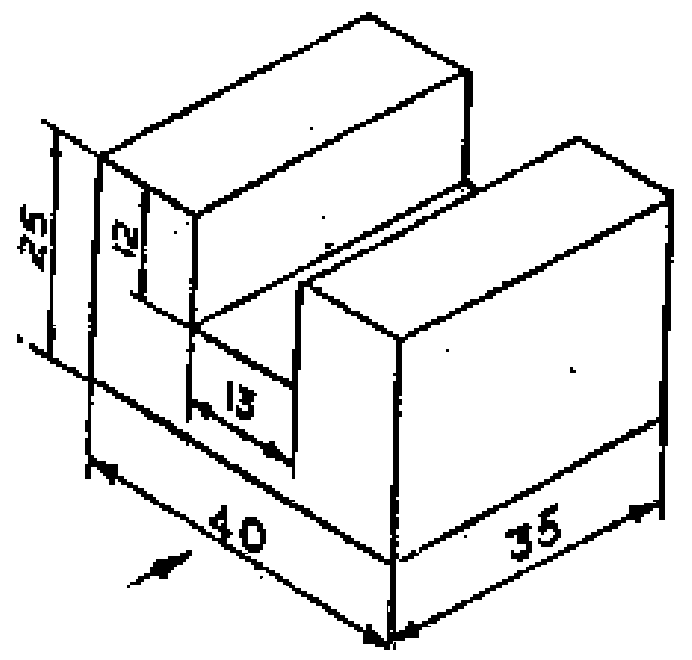 |
|
Figure 7 |
8. A rectangular lamina of sides 50 mm x 25 mm stands vertically with one of its longer edges on the ground and inclined at 45o to PP. The vertical edge nearest to PP is 20 mm behind it. The station point is 30 mm in front of the PP, 45 mm above the ground and lies in a central plane, which passes through the center of the lamina. Draw the perspective view. [16]
I B.Tech Supplementary Examinations, November 2009 ENGINEERING GRAPHICS ( Common to Civil Engineering, Mechanical Engineering, Mechatronics, Metallurgy & Material Technology, Production Engineering, Aeronautical Engineering and Automobile Engineering)
Time: 3 hours Max Marks: 80
Answer any FIVE Questions All Questions carry equal marks
1. Draw a vernier of R.F = 1:2.4 to show decimeters, centimeters and millimeters and long enough to read up to 6 decimeters. Mark a distance of 3.69 decimeters on the scale. [16M]
2. The foci of an ellipse are 100 mm apart and the minor axis is 70 mm long. Determine the length of the minor axis and draw half the ellipse by concentric circles method and the other half by Oblong method. Draw a curve parallel to the ellipse and 25 mm away from it. [16M]
3. Three lines OA, OB and OC are respectively 25 mm, 45 mm 65 mm long, each making 120 degrees angles with the other two and the shortest line being vertical. The figure is the top view of the three rods OA, OB and OC whose ends A, B and C are on the ground, while O is 100 mm above it. Draw the front view and determine the length of each rod and its inclination with the ground. [16M]
4. A hexagonal prism of base of side 40mm and axis length 80mm rests on one of its base edges on the HP. The end containing that edge is inclined at 300 to the HP and the axis is parallel to VP. It is cut by a plane perpendicular to the VP and parallel to the HP. The cutting plane bisects the axis. Draw its front and the sectional top views. [16M]
5. A hexagonal prism of side of base 30 mm and height 60 mm is resting on HP with one of its base edges parallel to VP. Right half of the solid is cut by an upward plane inclined at 60o to the ground and starting from the axis and 30 mm below the top end. The left half of the solid is cut by a plane inclined at 30o to the HP downwards from the axis. The two section planes are continues. Draw the development of the lower portion. [16]
6. Draw the isometric view of a cone 40 mm diameter and axis 55 mm long when its axis is horizontal. Draw isometric scale. [16]
7. Convert the isometric view of the picture shown in the figure 7 in to orthogonal projection of all three views. [16]
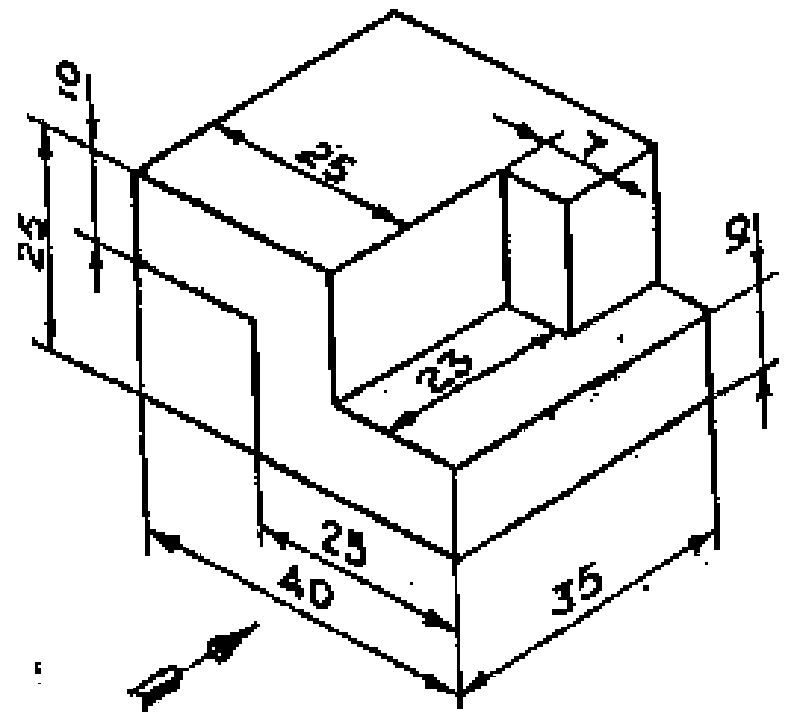 |
|
Figure 7 |
8. Draw the perspective view of a right regular hexagonal prism, edge of base 25 mm and 60 mm long lying on ground on one of its rectangular faces such that its axis is inclined at 30o to the picture plane and one of its vertical edges touching the picture plane. The station point is 80 mm in front of the picture plane, and lies in a central plane bisecting the axis. The horizon is in the level of the rectangular faces of the prism. [16]
k k k k k
I B.Tech Supplementary Examinations, November 2009 ELECTRONIC DEVICES AND CIRCUITS ( Common to Electrical & Electronic Engineering, Electronics & Communication Engineering, Computer Science & Engineering, Electronics & Instrumentation Engineering, Bio-Medical Engineering, Information Technology, Electronics & Control Engineering, Computer Science & Systems Engineering, Electronics & Telematics, Electronics & Computer Engineering and Instrumentation & Control Engineering)
Time: 3 hours Max Marks: 80
Answer any FIVE Questions All Questions carry equal marks
1. (a) Derive the expression for trajectory of an electron placed in combined elec-
tric(E) and magnetic fields(B). Both the fields are perpendicular to each other and the initial velocity is zero.
(b) The magnetic flux density B = 0.02wb/m2 and electric field strength E = 105v/m are uniform fields, perpendicular to each other.A pure source of an electron is placed in a field. Determine the minimum distance from the source at which an electron with 0v will again have 0v in its trajectory under the influence of combined Electric and magnetic fields. [8+8]
2. (a) Compare the performance characteristics of Si and Ge diodes.
(b) For a Si diode with reverse saturation current of 5 nA, calculate the dynamic forward and reverse resistance at a voltage of 0.4V and -0.4V respectively, applied across the diode. Assume room temperature of 270 C. [16]
3. (a) Explain why a bridge rectifier is preferred over a centre-tap rectifier.
(b) Explain the necessity of a bleeder resistor.
(c) A diode has an internal resistance of 20Q and 1000Q load from a 110V rms source of supply. Calculate
i. the efficiency of rectification
ii. the percentage regulation from no load to full load. [4+4+8]
4. (a) For the transistor switching circuit shown in figure 4(a)iii, determine the fol
lowing:
i. What is Vce when there is no input voltage, Vin
ii. What minimum value of IB is required to saturate the transistor?
iii. Calculate the maximum value of RB to keep the transistor under saturation when Vin=6V.
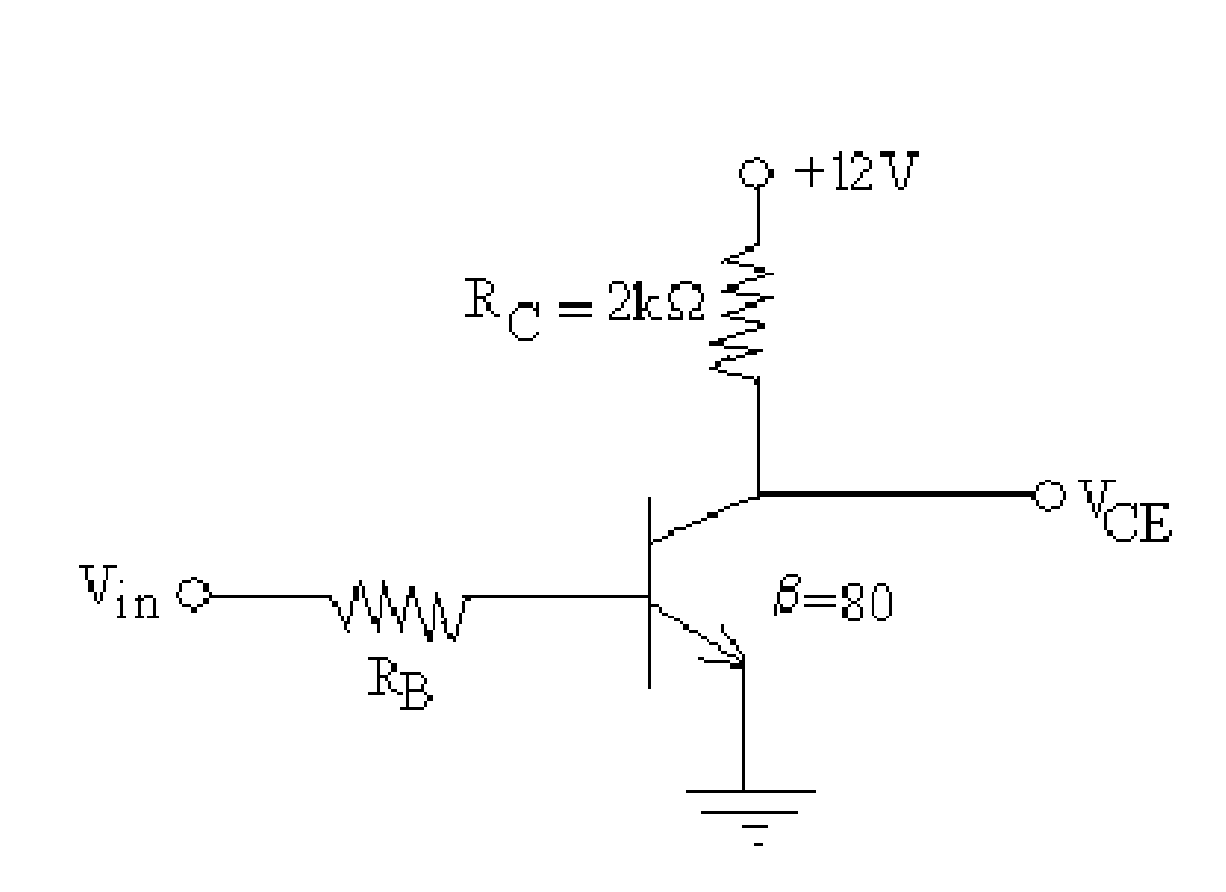 |
|
Figure 4(a)iii (b) Use proper diagrams to explain the structure of enhancement only type MOS-FETs. Why are the devices so named? Can they be operated in the depletion mode? [10+6] |
5. (a) What do you understand by bias stabilization and bias compensation? Why is it necessary in transistor amplifiers? [3+3+2]
|
(b) For the circuit shown (figure 5), calculate IB, Ic, IE and VCE [2+2+2+2] |
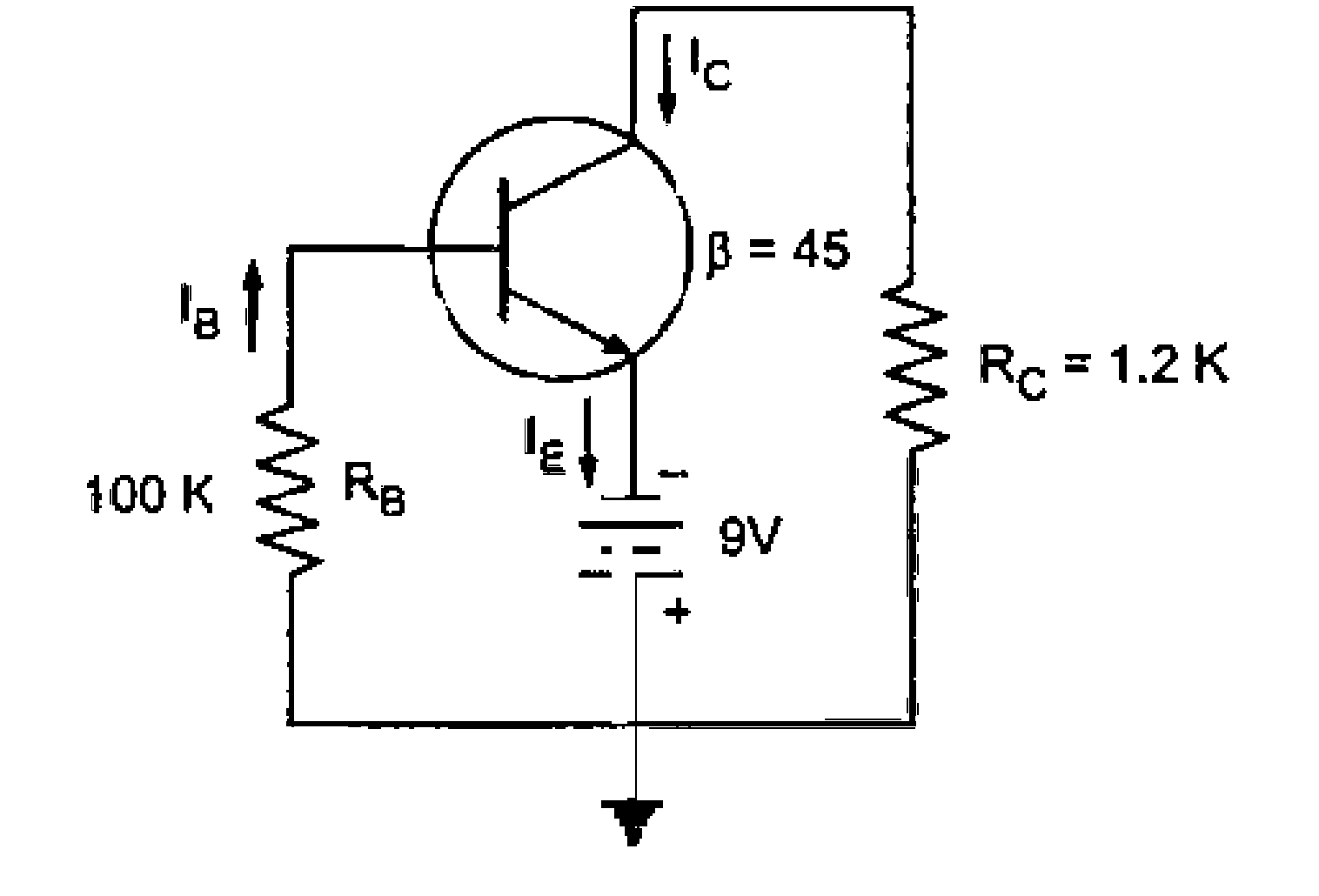 |
|
Figure 5 |
6. (a) Draw the low frequency small signal model of a transistor in CB and CE configurations and explain significance of each model. [2+2+2+2]
|
(b) The amplifier circuit shown in figure 6 uses a transistor with h/e=100, hie=3.37K. Calculate AI, AV, RI. [3+3+2] |
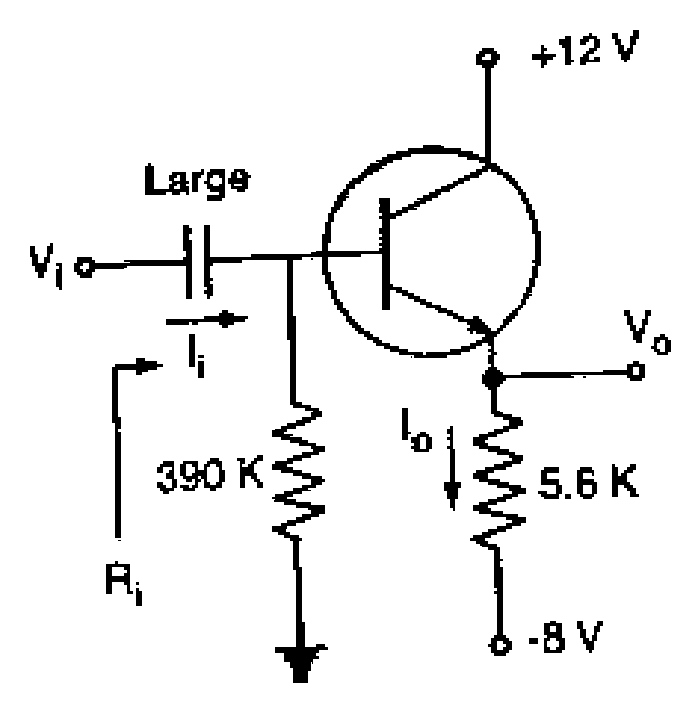 |
|
Figure 6 |
(a) Draw the circuit diagram of current shunt feedback and derive expressions for input and output resistances. [4+6]
7.
(b) An amplifier with current sires feedback has the form shown in figure 7. The transistor has h/e=100, hie=2k, RC=4700 and RE consists of two 100 Q resistors, one is bypassed by capacitor CE. Calculate the values of voltage gain and input resistance without feed back. [6]
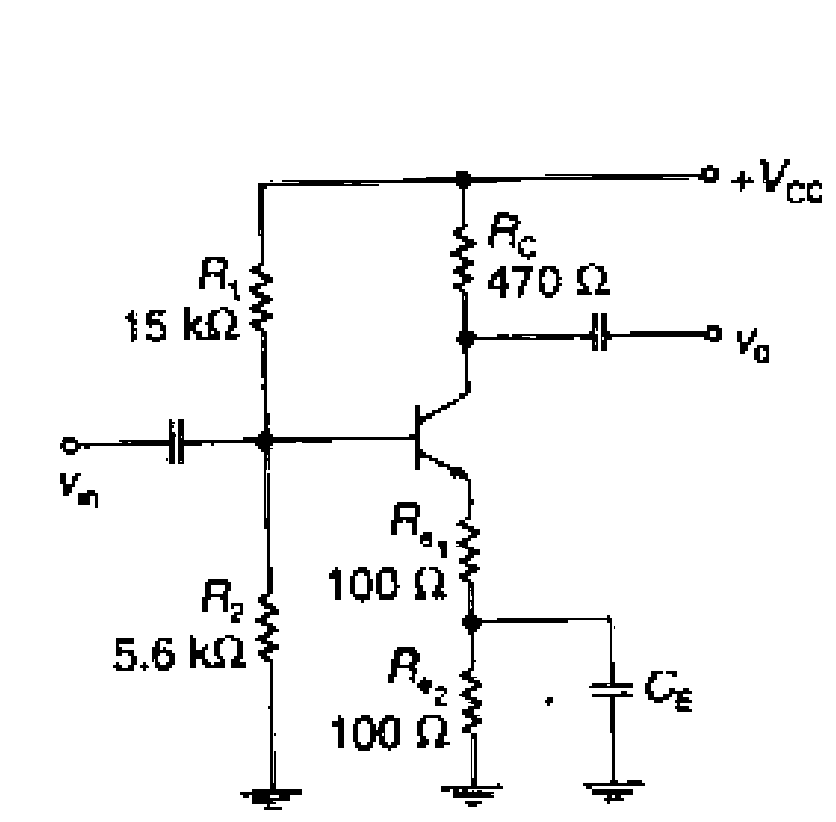 |
|
Figure 7 |
(a) Draw the circuit diagram of a RC phases shift oscillator using BJT. Derive the expression for frequency of oscillators.
(b) Classify different type of oscillators based on frequency range.
(c) Why RC oscillators are not suitable for high frequency applications. [8+4+4]
'k 'k 'k 'k 'k
I B.Tech Supplementary Examinations, November 2009 ELECTRONIC DEVICES AND CIRCUITS ( Common to Electrical & Electronic Engineering, Electronics & Communication Engineering, Computer Science & Engineering, Electronics & Instrumentation Engineering, Bio-Medical Engineering, Information Technology, Electronics & Control Engineering, Computer Science & Systems Engineering, Electronics & Telematics, Electronics & Computer Engineering and Instrumentation & Control Engineering)
Time: 3 hours Max Marks: 80
Answer any FIVE Questions All Questions carry equal marks k k k k k
1. (a) Give the block diagram of CRO and explain about each block in detail?
(b) In a electrostatic deflecting CRT the length of the deflection plats is 2cm, and spacing between deflecting is 0.5cm, The distance from the cenlve of the deflecting plate to the screen is 20cm, the deflecting voltage is 25V Find the deflecting sensitivity, the angle of diction and velocity of the beam. Assume final anode potential is 1000V. [8+8]
2. (a) i. What in a zener diode? How does it differ from an ordinary pn-junction
rectified diode?
ii. Give the V-I characteristics of zener diode and explain its salient features in relation to that of pn diode.
iii. Give the equivalent model of zener diode under the reverse biased condition.
(b) Using analytical expression for diode current calculate the dynamic slope resistance of a Ge diode at 2900k when forward biased at current of 10 A.
[4+4+2+6]
3. (a) With a circuit diagram and waveforms, derive an expression for ripple factor
of full wave rectifier with capacitor filter.
(b) Determine the ripple factor of an L-type choke input filter comprising of a 10H choke and 8F capacitor, used with a FWR. Compare the above result with a sample 8 F capacitor input filter with a load current of 50mA and also 150mA assuming the d.c O/P voltage to be 50V. Neglect d.c. resistance of choke and assume supply frequency of 50Hz. [16]
4. (a) What is photo diode? How does it function? Give it characteristics and
describe one of its applications.
(b) Describe a unijunction transistor (UJT). Draw its equivalent circuit and hence define the internsic stand off ratio. Draw its characteristics curve and explain the various parameters. [10+6]
5. (a) Explain how do you set a Q point in a self biased JFET. [4+4]
(b) For the FET self biased circuit shown (figure 5), calculate the values of RD and RS to obtain the bias condition. The maximum drain current is 10mA and Vgs = -2.2V at ID=5mA. [4+4]
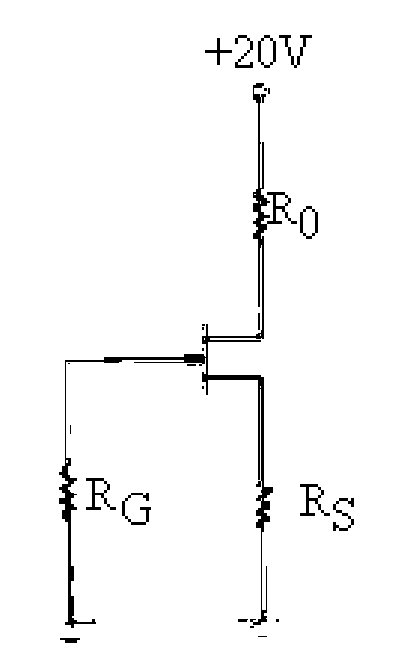 |
|
Figure 5 |
6. (a) Draw the circuit diagram of common drain amplifier and derive expressions
for voltage gain and output resistance. [2+3+3]
(b) Draw the equivalent circuit for CE and CC configurations subject to the restriction that Rl=0. Show that the input impedances for the two circuits are identical. [2+2+4]
7. (a) Explain the concept of feedback with block diagram. [4+4]
(b) An Amplifier with negative feedback gives an output of 12.5V with an input of 1.5V. When feedback is removed, it requires 0.25V input for the same output. Find
i. value of voltage gain without feedback
[3+5]
ii. value of ft, if the input and output are in phase and ft is real.
(a) Derive the expression for frequency of oscillations in RC-phase shift oscillator using BJT.
8.
(b) A crystal has L=0.1H, C=0.01PF, R=10kQ and CM=1PF. Find the series resonance and Q-factor. [8+8]
k k k k k
I B.Tech Supplementary Examinations, November 2009 ELECTRONIC DEVICES AND CIRCUITS ( Common to Electrical & Electronic Engineering, Electronics & Communication Engineering, Computer Science & Engineering, Electronics & Instrumentation Engineering, Bio-Medical Engineering, Information Technology, Electronics & Control Engineering, Computer Science & Systems Engineering, Electronics & Telematics, Electronics & Computer Engineering and Instrumentation & Control Engineering)
Time: 3 hours Max Marks: 80
Answer any FIVE Questions All Questions carry equal marks
1. (a) Derive the expression for trajectory of an electron placed in combined elec-
tric(E) and magnetic fields(B). Both the fields are perpendicular to each other and the initial velocity is zero.
(b) The magnetic flux density B = 0.02wb/m2 and electric field strength E = 101v/m are uniform fields, perpendicular to each other.A pure source of an electron is placed in a field. Determine the minimum distance from the source at which an electron with 0v will again have 0v in its trajectory under the influence of combined Electric and magnetic fields. [8+8]
2. (a) At constant current I, how does the diode voltage V vary with temperature?
Under forward biased conditions, how do the dynamic resistance Vd vary if the diode current is increased?
(b) A Ge diode has a reverse saturation current of 3A. Calculate the voltage at which 1% of the vated current will flow thorough the diode, at room temperature if diode is rated for 1A. [16]
3. (a) Explain why a bridge rectifier is preferred over a centre-tap rectifier.
(b) Explain the necessity of a bleeder resistor.
(c) A diode has an internal resistance of 20Q and 1000Q load from a 110V rms source of supply. Calculate
i. the efficiency of rectification
ii. the percentage regulation from no load to full load. [4+4+8]
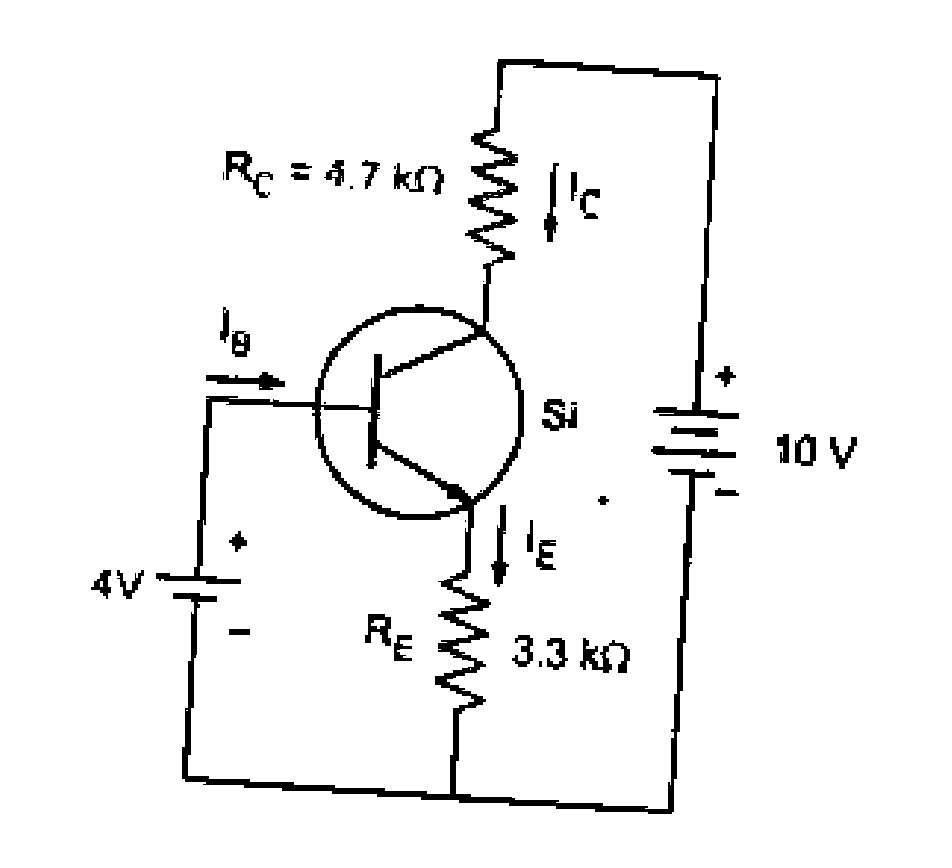 |
|
Figure 5 |
6. (a) Discuss the effect of coupling capacitor (Cc) on low frequency response of CE
amplifier. [6]
(b) For a CB transistor amplifier driven by a voltage source of internal resistance Rs = 1.2k the load impedance is resistor RL = 1k. The h-parameters are hib=22Q., hfb= - 0.98, hob= 0.5 A/V, hrb= 3 x 10-4 . Calculate AV, Aj,and
Ri . [31/2 + 31/2 + 3]
7. (a) What is the equation relating AV and 0 in a single loop feedback amplifier?
Define [2+2+2+2]
i. Desensitivity
ii. Negative feedback
iii. Positive feedback
(b) An amplifier has an open loop gain of 1000 and a feedback ratio of 0.04. If the open loop gain changes by 10% due to temperature, find the percentage change in gain of the amplifier with feedback. [8]
8. (a) Draw the circuit diagram of a RC phases shift oscillator using BJT. Derive
the expression for frequency of oscillators.
(b) Classify different type of oscillators based on frequency range.
(c) Why RC oscillators are not suitable for high frequency applications. [8+4+4]
k k k k k
I B.Tech Supplementary Examinations, November 2009 ELECTRONIC DEVICES AND CIRCUITS ( Common to Electrical & Electronic Engineering, Electronics & Communication Engineering, Computer Science & Engineering, Electronics & Instrumentation Engineering, Bio-Medical Engineering, Information Technology, Electronics & Control Engineering, Computer Science & Systems Engineering, Electronics & Telematics, Electronics & Computer Engineering and Instrumentation & Control Engineering)
Time: 3 hours Max Marks: 80
Answer any FIVE Questions All Questions carry equal marks
1. (a) Give the block diagram of CRO and explain about each block in detail?
(b) In a electrostatic deflecting CRT the length of the deflection plats is 2cm, and spacing between deflecting is 0.5cm, The distance from the cenlve of the deflecting plate to the screen is 20cm, the deflecting voltage is 25V Find the deflecting sensitivity, the angle of diction and velocity of the beam. Assume final anode potential is 1000V. [8+8]
2. (a) Show that in the p-type semiconductor, the Fermi level lies above the top of
the valences babd.
(b) Determine the concentration of free electrons and holes in a sample of Si at 3000K which has a concentration of donor atoms equal to 1014 atoms/cm3 and a concentration of acceptor atoms equal to 1.5 x 1014 atoms/cm3. Is thus p-type or n-type silicon. [16]
3. (a) Differentiate between:
i. Full wave rectifier and bridge rectifier
ii. Choke input filter and capacitor input filter.
(b) A full wave single phase rectifier circuit makes use of two diodes the internal forward resistance of each of which can be considered to be constant and equal to 20Q. The load resistance in 1KQ. The transformer secondary voltage in 100-0-100V (rms)-calculate:
i. D.C.load current
ii. D.C.O/P voltage
iii. PIV
iv. RMS voltage across each diode. [16]
4. (a) Obtain the relation between JFET parameters giving their definitions.
(b) What is thermal runaway in BJT? How can it be avoided? Is the thermal runaway possible in JFET? [10+6]
5. (a) List the three sources of instability of collector current and define three sta
bility factors. [4+4]
|
(b) For the circuit shown (figure 5), calculate IB, Vc and VCE |
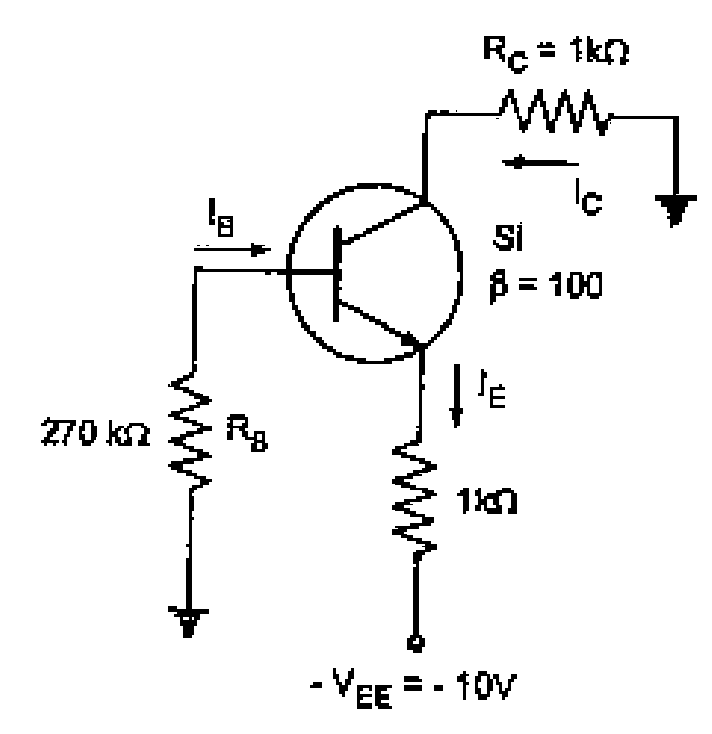 |
|
Figure 5 |
6. (a) Draw the circuit diagram of common drain amplifier and derive expressions
for voltage gain and output resistance. [2+3+3]
(b) Draw the equivalent circuit for CE and CC configurations subject to the restriction that Rl=0 Show that the input impedances for the two circuits are identical. [2+2+4]
7. (a) Explain negative feedback with the help of the emitter follower as an example.
Why is the emitter follower so called? [8]
(b) The gain of an amplifier is decreased to 10,000 with negative feedback from its gain of 60,000. Calculate the feedback factor. Express the amount of negative feedback in dB. [8]
8. (a) Show that the gain of Wien bridge oscillator using BJT amplifier must be at
least 3 for the oscillations to occur.
(b) In a transistorized Hartley oscillator the two inductances are 2mH and 20H while the frequency is to be changed from 950KHZ to 2050KHZ. Calculate the range over which the capacitor is to be vaired. [10+6]
I B.Tech Supplementary Examinations, November 2009 INTRODUCTION TO CHEMICAL ENGINEERING (Chemical Engineering)
Time: 3 hours Max Marks: 80
Answer any FIVE Questions All Questions carry equal marks
1. (a) Explain the equilibrium state of an operation with the help of Gibbs phase
rule.
(b) Define the rate of a process. [12+4]
2. (a) Describe the heat of reaction at constant pressure and at constant volume.
(b) Explain Hesss law of heat summation. [8+8]
3. (a) Differentiate between a pump, a fan and a compressor.
(b) What is a multistage pump? Explain.
(c) Give a brief account of rotary pumps. [6+4+6]
4. Write a note on multiple-effect evaporators and methods of feeding with suitable diagram. [16]
5. (a) Define phases. Differentiate between one phase and two phases by means of
examples.
(b) What do you mean by interphase mass transfer? Explain with a neat figure and an example.
(c) Why is the resistance to mass transfer zero at the interface? Give the equilib-rim relationship between partial pressure of a component A and concentration of A in the liquid phase at the interface. [4+8+4]
6. (a) Define extractive distillation.
(b) Briefly explain about fractional distillation.
(c) Briefly explain the McCabe-Thiele method for calculating the number of theoretical stages in distillation column. [2+6+8]
7. (a) What do you understand by the term distribution coefficient with respect
to liquid-liquid extraction? Explain with reference to dilute solutions and concentrated solutions.
(b) Explain the use of triangular diagram in liquid-liquid systems with a neat figure.
(c) What are the various points to be considered in the selection of the phase to be dispersed? [6+6+4]
8. (a) Give a detailed account of the classification of crystallization equipment.
(b) Write short notes on scraped surface crystallizer.
k k k k k
[12+4]
I B.Tech Supplementary Examinations, November 2009 INTRODUCTION TO CHEMICAL ENGINEERING (Chemical Engineering)
Time: 3 hours Max Marks: 80
Answer any FIVE Questions All Questions carry equal marks k k k k k
1. (a) Define fundamental units and dimensions useful in chemical engineering, write
dimensional formulae for Force and Energy.
(b) Define the units of major eight (8) quantities used in SI system.
(c) Explain the basis of dimensional analysis. [4+8+4]
2. (a) Explain the function of Galvanic (or voltaic) cell.
(b) Explain electrolysis process and state the electromotive series of metals. [8+8]
3. (a) Explain shear stress versus shear rate plot for different fluids.
(b) Define stream line and a stream tube. [12+4]
4. Derive the expression for log mean temperature difference for parallel flow heat exchanger. What are the conditions under which it is valid? [16]
5. (a) What are the combination of parameters used to study binary vapor-liquid
equilibrium systems? Show how they can be obtained from phase rule.
(b) Define relative volatility in terms of partial pressure of pure component and mole fraction in liquid phase for a binary system obeying Raoults law. Derive the exression for yA in terms of aAB and xA.
(c) Absorption or stripping processes may be handled either statically or kineti-cally. Explain. [6+6+4]
6. (a) Define Reflux Ratio.
(b) Describe the McCabe-Thiele method of calculation of number of theoretical stages. [4+12]
7. (a) Define the following terms with respect to gas-liquid mass transfer operations:
i. Cross flow
ii. Dual flow
iii. Split flow
iv. Turndown ratio.
(b) Explain the following terms and give their effect on the gas-liquid mass transfer operation:
i. Entrainment
ii. Weeping. [8+4+4]
8. (a) Distinguish between physical and chemical adsorption.
[8+8]
(b) Define and explain the process of adsorption.
I B.Tech Supplementary Examinations, November 2009 INTRODUCTION TO CHEMICAL ENGINEERING
(Chemical Engineering)
Max Marks: 80
Time: 3 hours
Answer any FIVE Questions All Questions carry equal marks
k k k k k
1. (a) Explain how we can estimate the ratio of masses of two immiscible liquids using their vapour pressers.
(b) Explain the applications of Cox chart and Duhring plot.
[8+8]
[8+8]
2. (a) Write about the different types of flow diagrams.
(b) Define the following terms
i. Recycling
ii. Purging
iii. Bypassing
iv. Steady state.
3. (a) Differentiate between a pump, a fan and a compressor.
(b) What is a multistage pump? Explain.
(c) Give a brief account of rotary pumps. [6+4+6]
4. (a) Describe the typical flow arrangements in heat exchangers with neat diagrams.
(b) Mention any four applications of heat exchangers in process plants.
(c) Write a brief note on double pipe heat exchanger. [6+4+6]
5. (a) What are the three main problems that arise when a gas and liquid flow
through a packed bed? Discuss in detail about their effects on mass transfer and suggest ways of reducing them.
(b) Write the overall mole balance at steady state for designing a packed absorption column, and explain the terms involved. [10+6]
6. (a) Define Reflux Ratio.
(b) Describe the McCabe-Thiele method of calculation of number of theoretical stages. [4+12]
7. (a) Describe the following terms in gas liquid operations:
i. Weeping
ii. Hydraulic gradient
iii. Hold up
iv. Axial mixing.
(b) Describe operation of packed column for gas liquid operations. [8+8]
8. Discuss in detail about the various types of adsorption equipment.
[16]
I B.Tech Supplementary Examinations, November 2009 INTRODUCTION TO CHEMICAL ENGINEERING (Chemical Engineering)
Time: 3 hours Max Marks: 80
Answer any FIVE Questions All Questions carry equal marks
1. Explain the Rayleigh and Buckingham methods of dimensional analysis. [16]
2. (a) Energy associated with mass may be classified in a number of ways. What are
they?
(b) What are the different ways by which energy that is not associated with mass classified?
(c) Define standard heat of reaction and discuss about heats of reaction at constant pressure and constant volume. [5+2+9]
3. (a) Define shear stress and explain coefficient of viscosity from Newtons law of
viscosity.
(b) Explain the following: [8+8]
i. An ideal fluid
ii. Compressible fluid
iii. Modulus of elasticity
iv. Coefficient of thermal expression.
4. (a) How are heat exchangers classified on the basis of flow arrangements? Explain
with neat diagrams.
(b) Show the variation fluid temperature along the length of heat exchanger based on flow arrangement and on the ratio of water equivalents of the fluid, by means of neat figures.
(c) Show that the ratio of the difference in inlet and outlet temperatures of the cold and hot fluids is inversely proportional to the ratio of their water equivalents.
[6+8+2]
5. (a) Explain interphase mass transfer and mass transfer Coefficient.
(b) Describe the overall mass transfer coefficient in terms of individual film coefficients. [8+8]
6. (a) Explain plate efficiency. What are different types of plate efficiencies?
(b) Write on any two of the following: [6+10]
i. Flash distillation
ii. Steam distillation
iii. Azeotropic distillation.
7. (a) With a neat sketch briefly explain the construction and working principle of
packed column and discuss the merits and demerits of the same.
(b) What is meant by fractional extraction? [12+4]
8. (a) How are industrial crystallizers classified according to the manner in which
supersaturated liquid contacts the growing crystals?
(b) With a neat figure, discuss about circulating magma-vacuum crystallizer.
[6+10]
2 of 2
(a) Explain the reasons for keeping the operating point of a transistor as fixed.
(b) For the circuit shown (figure5), calculate VE, IE, Ic and Vc. Assume VBE=0.7V.
[8+8]
|
Attachment: |
| Earning: Approval pending. |
